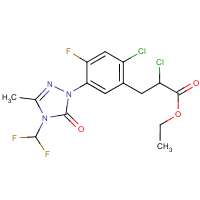Carfentrazone-ethyl
Agent Name
Carfentrazone-ethyl
CAS Number
128639-02-1
Formula
C15-H14-Cl2-F3-N3-O3
Major Category
Pesticides

Synonyms
Aim; Aurora; Aurora (pesticide); Aurora 50WG; F 8426; F8426; Kuaimieling; Spotlight; Spotlight 24EC; Benzenepropanoic acid, .alpha.,2-dichloro-5-(4-(difluoromethyl)-4,5-dihydro-3-methyl-5-oxo-1H-1,2,4-triazol-1-yl)-4-fluoro-, ethyl ester; Ethyl 2-chloro-3-(2-chloro-4-fluoro-5-(4-(difluoromethyl)-4,5-dihydro-3-methyl-5-oxo-1H-1,2,4-triazol-1-yl)phenyl)propanoate; [ChemIDplus] Quicksilver; [ACGIH]
Category
Herbicides, Protox-Inhibiting
Description
Yellow liquid; [Merck Index] Yellow-orange liquid with a mild odor of petroleum; [HSDB] Viscous yellow-orange liquid; [ACGIH]
Sources/Uses
Used as post-emergence herbicide for control of broadleaf weeds, winter annuals, and mustards in cereals, corn, cotton, and rice; Also used as cotton defoliant; [HSDB] Also used on turf and ornamentals; [ACGIH]
Comments
“The lowest NOAEL of 3 mg/kg was found in female rats from a 2-year chronic study and this number is used as the basis for the recommended limit. Higher doses produce both liver damage and increased urinary porphyrin excretion.” No human data available; [ACGIH] The protox inhibitor herbicides (Fomesafen, Oxadiazon, Lactofen, Sulfentrazone, Carfentrazone-ethyl, Oxyfluorofen and Bifenox) can disrupt porphyrin metabolism; "It has been speculated that a transient form of porphyria variegate may occur following a massive exposure or long-term exposure to lower doses." [HSDB] May cause irritation; [MSDSonline] See "Fluthiacet-methyl."
Reference Link #1
Biomedical References
Exposure Assessment
TLV (ACGIH)
1 mg/m3, inhalable particulate matter
Vapor Pressure
1.2E-07 mm Hg
Lethal Concentration
LC50 (rat) >5,090 mg/m3;
Adverse Effects
Hepatotoxin
Hepatoxic (a) from occupational exposure (secondary effect) or (b) in animal studies or in humans after ingestion
ACGIH Carcinogen
Not Classifiable
Diseases, Processes, and Activities Linked to This Agent
Processes
Industrial Processes with risk of exposure: